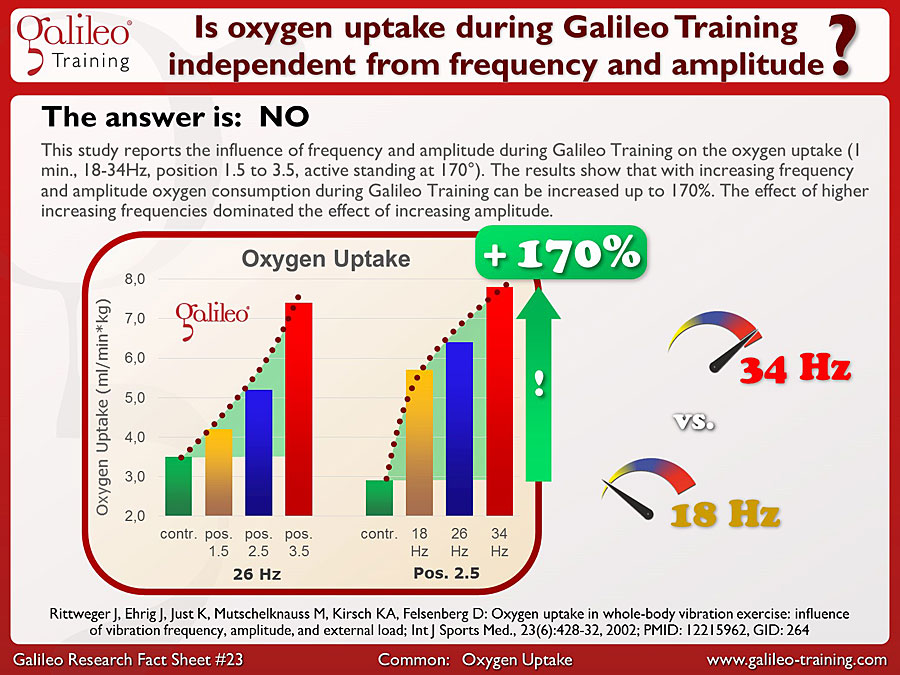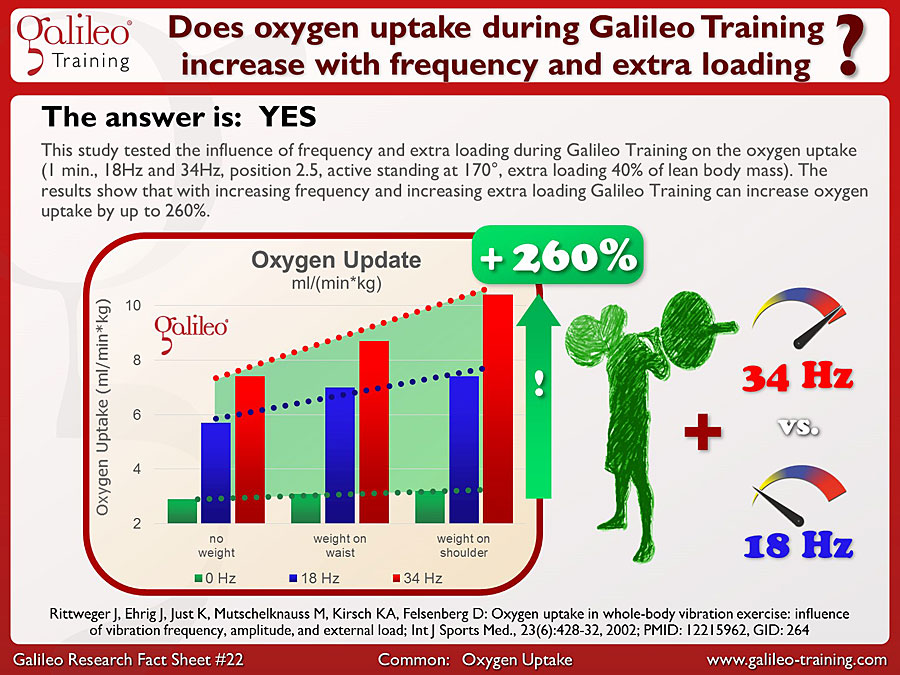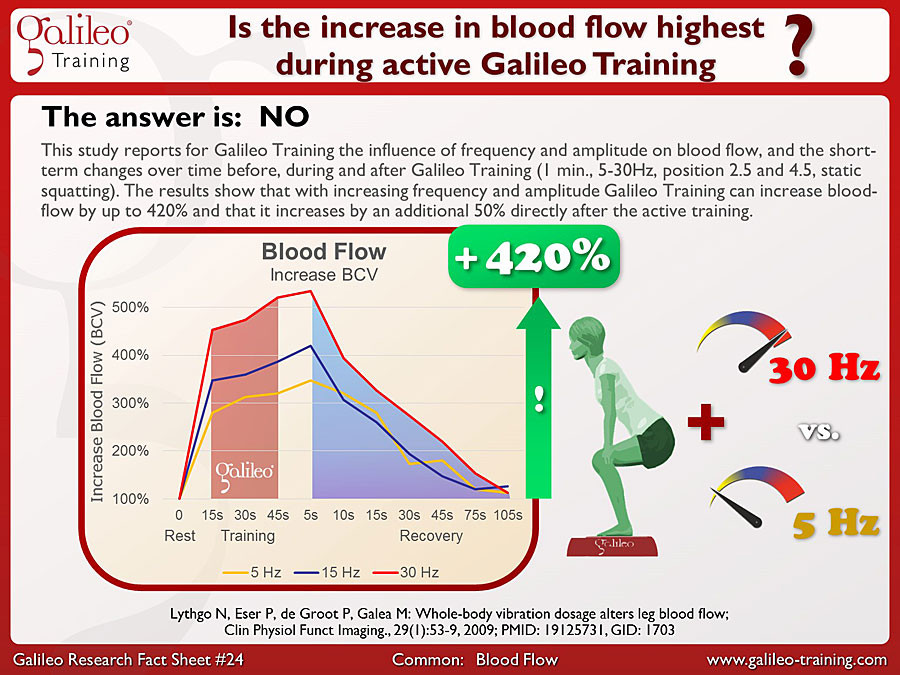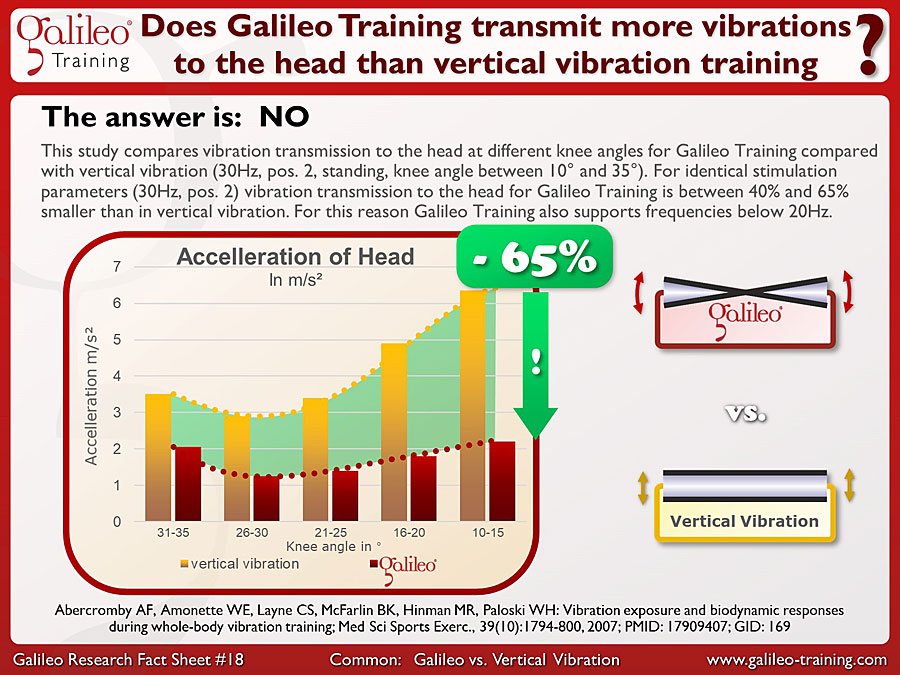This study shows the changes of muscle histology and muscle function using exhaustive Galileo Training for athletes (25Hz, 2 sets squats until exhaustion (max. 3 min.) with 40% (start) to 80% (end) body weight extra load, pos. 3-4, 2/week, 6 week). The Galileo group increase muscle fiber cross-section by 95% (Type 2) and 23% (Type 1) and the 1 Repetition Maximum (1RM) by 25% (from 111kg to 141kg)...
Galileo Research Facts No. 28: Can Galileo Training compensate the negative effects of HIT on anaerobic power?
This study used Galileo Training in rest phases between High Intensity Training (HIT) intervals to reduce loss of anaerobic power (20 Sessions HIT, HIT+18Hz/HIT+30Hz, 3 min., pos. 3, knees half bent). Galileo Training during rest phases could compensate the HIT associated loss of anaerobic power and MyHC-2x fiber cross-sectional area completely. Galileo Training at 18 Hz showed about 20% higher effects than training at 30Hz...
Galileo Info Sheet #1: Galileo Training Galileo Training Frequencies: Which frequency when and why?
Galileo Info Sheet #1: Galileo Training – Frequncy ranges and their apllications - What frequency is needed for which training goal?
Galileo Research Facts No. 23: Is oxygen uptake during Galileo Training independent from frequency and Amplitude?
This study reports the influence of frequency and amplitude during Galileo Training on the oxygen uptake (1 min., 18-34Hz, position 1.5 to 3.5, active standing at 170°). The results show that with increasing frequency and amplitude oxygen consumption during Galileo Training can be increased up to 170%. The effect of higher increasing frequencies dominated the effect of increasing amplitude...
Galileo Research Facts No. 22: Does oxygen uptake during Galileo Training increase with frequency and extra loading?
This study tested the influence of frequency and extra loading during Galileo Training on the oxygen uptake (1 min., 18Hz and 34Hz, position 2.5, active standing at 170°, extra loading 40% of lean body mass). The results show that with increasing frequency and increasing extra loading Galileo Training can increase oxygen uptake by up to 260%.
Galileo Research Facts No. 21: Does blood-flow during Galileo Training increase with frequency and Amplitude?
This study reports the influence of frequency and amplitude during Galileo Training on the blood-flow (1 min., 5-30Hz, position 2.5 and 4.5, static squatting). The results show that with increasing frequency and increasing amplitude blood-flow velocity during Galileo Training can be increased by 220% to 420%.
Galileo Research Facts No. 20: Can Galileo Training increase blood flow?
This study reports the immediate effect of Galileo Training on blood flow (26Hz, Pos. 2, 3 minutes, slow squatting, additional weights +35% to +40% of body mass). Control group: Cycling ergometer, 3 min., 50W. In the Galileo Training group blood flow at the foot and calf increase between 120% and 150%. At the same time the cardiovascular reaction is significantly smaller than in cycling ergometer training. ..
Galileo Research Facts No. 24: Is the increase in blood flow highest during active Galileo Training?
This study reports for Galileo Training the influence of frequency and amplitude on blood flow, and the short-term changes over time before, during and after Galileo Training (1 min., 5-30Hz, position 2.5 and 4.5, static squatting). The results show that with increasing frequency and amplitude Galileo Training can increase blood-flow by up to 420% and that it increases by an additional 50% directly after the active training...
Galileo Research Facts No. 19: Can Galileo Training improve short-term leg-press Performance?
This study tested the immediate effect of Galileo Training on one-legged leg-press performance (only 1 leg on Galileo, other leg as control, 10x1 min., 1. min. rest, 26Hz, pos. 4, one-legged on toes, knee angle 100°-110°). Comparison between trained and untrained leg immediately before and after the training. The Galileo Training leg improved velocity and power in the leg-press exercise almost independent of extra loads by almost 10%. ..
Galileo Research Facts No. 18: Does Galileo Training transmit more vibrations to the head than vertical vibration training?
This study compares vibration transmission to the head at different knee angles for Galileo Training compared with vertical vibration (30Hz, pos. 2, standing, knee angle between 10° and 35°). For identical stimulation parameters (30Hz, pos. 2) vibration transmission to the head for Galileo Training is between 40% and 65% smaller than in vertical vibration. For this reason Galileo Training also supports frequencies below 20Hz...








